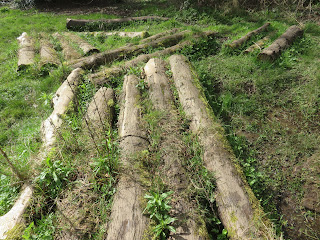Heath Park is a wonderful nature conservation area
Heath Park Second Pond (Photo: Steve Andrews)
Heath Park in Cardiff is a wonderful area for nature conservation and is home to a colony of the rare great crested newt (Triturus cristatus). The amphibians breed in the pond there that has been in the park for very many years.
Great Crested Newts
Those responsible for the park and pond’s upkeep have very wisely left dead tree-trunks around the edges of the pool and in the woodland that surrounds it.
Habitat created for Great Crested Newts (Photo: Steve Andrews)
Water plants, such as watercress (Nasturtium officinale) are enclosed in mesh so that they are protected and this creates a wonderful area for the newts to lay their eggs in and to hide. Great crested newt females wrap their eggs in the leaves of aquatic vegetation, as do other species of newt.
Aquatic plants (Photo: Steve Andrews)
An information board gives a lot of information about the great crested newt, including how far it travels away from water. The much smaller palmate newt (Lissotriton helveticus) also breeds in Heath Park Pond. This comes as no surprise to me because I used to have a girlfriend many years ago, who lived in the nearby King George V Drive that circles Heath Park, and these far commoner newts could be found in the garden pool of the house where she lived. On the info board, there are illustrations and notes about the other interesting species of wildlife that can be seen in the pond. The common frog (Rana temporia) is another amphibian that breeds here.
Info board (Photo: Steve Andrews)
Aquatic insects that use the Heath park Pond include the great diving beetle (Dytiscus marginalis), the water boatman (Notonecta glauca) and dragonfly and damselfly species. The great diving beetle and its larva hunt tadpoles, small newts, fish and worms. The larvae have large mandibles with which they grab their prey as they suck out the life-blood. Both adults and larvae will bite. The adult beetles fly by night to look for suitable stretches of freshwater. The water boatman or backswimmer can also fly. It is a predatory bug that feeds on mosquito larvae and other small water creatures. It gets its name from its habit of swimming upside down and using its legs as paddles to propel it through the water.
Alien and invasive species
Parrot's Feather
The information board includes a warning and request: the public are asked not to release species that are non-native and alien to this country. An example being species of terrapin that can be a danger to British wildlife. The species of water milfoil known as parrot’s feather (Myriophyllum aquaticum) is mentioned as an example of an invasive species, and it is pointed out that this particular plant caused a problem at Heath Park Pond where it grew abundantly and had to be carefully removed. It is a threat to British species because it grows so well that it displaces native plants.
Elsewhere in Heath Park
Elsewhere in Heath Park they have constructed a second pond near the golfing area. The information board explains that great crested newts do best in places where there are more than one pond, so that if one pond dries up in hot weather, for example, the amphibians can still breed in another. I don’t know if any newts are using it but it is certainly big enough and there were two mallard drakes swimming around on it.
Walking a dog to Heath Park Main Pond
There is quite a lot of woodland and areas which were once rough ground and scrub have been allowed to grow into thickets of small trees and bushes. There are plenty of great places for birds and other wildlife to live in the park. It is reported that the green woodpecker (Picus viridis) lives in this woodland, and I wouldn't be at all surprised because it is a great place for them.
Paths help you enjoy walking around the woodland and many people take their dogs for walks in Heath Park.
In the grassland and extensive lawns of Heath Park there are extensive colonies of lady’s smock or cuckooflower (Cardamine pratensis), which takes its name from its habit of flowering around the time when the first cuckoos could be expected to arrive in the UK.
Cuckoo Flowers (Photo: Steve Andrews)
It is of especial interest, and a useful plant when it comes to wildlife conservation, because it is one of the main food plants of the caterpillar of the orange tip butterfly (Anthocharis cardamines). This pretty species, with orange tips on the forewings of the males, has been increasing again in numbers in some parts of Britain, so anywhere that plants that its larvae feed on grow, is going to be helpful in ensuring this butterfly’s survival. The cuckoo flower used to be gathered as a substitute for watercress, and like the latter plant it likes to grow near water.
The abundance of lady’s smock plants in the park, as well as the natural woodland, and the obvious great attention that had been paid to making the ponds a suitable habitat for great crested newts and other aquatic wildlife, made me feel that Heath Park is one of the best parks in Cardiff for nature conservation.






No comments:
Post a Comment